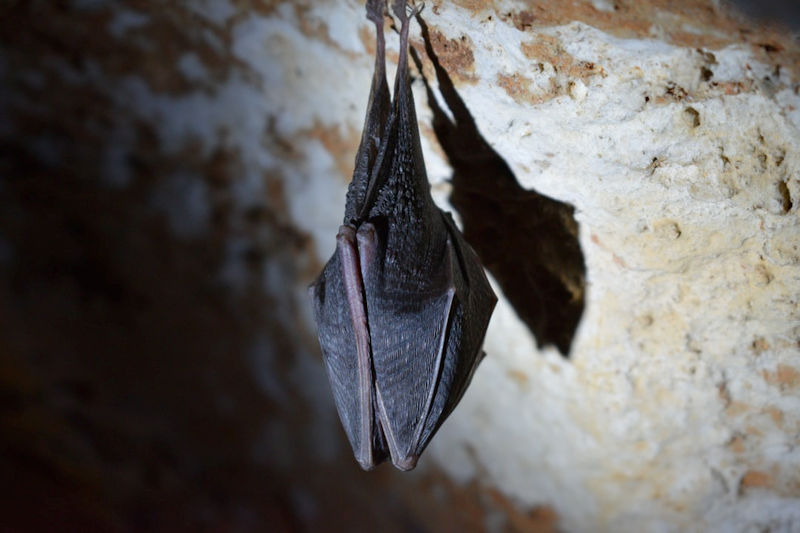Some bats can be pretty significant, with a wingspan that stretches up to 16 inches and individual bats weighing anywhere from 0.11 to 1.9 ounces. If a bat has entered your home, never try to deal with it yourself. This wild animal could attack when you least expect it.
How do bats enter the attic, and what should you do if you find one? Continue reading this guide to figure out how to repair bat damage and the importance of humane bat removal.
How Bats Enter Attic and the Importance of Humane Bat Removal
Have you ever wondered how bats enter your home’s attic? It may seem impossible, but these clever creatures have some tricks. In this article, we will explore the various ways bats enter your home’s attic and why it is crucial to remove them humanely. We will also discuss the importance of repairing any damage caused by bats and how to safeguard your home from future bat invasions.
1. The Bat Invasion: How Bats Enter Attics
Bats are excellent climbers and flyers, allowing them to enter your home’s attic through various access points. Here are some common ways bats infiltrate attics:
- Cracks and Openings: Bats can fit through small cracks and openings as tiny as a quarter of an inch. This astonishing ability allows them to take advantage of any vulnerable areas on the roofline, damaged vents, and even gaps between building materials. Because bats can flatten their bodies to squeeze through tight spaces, homeowners may not even realize the small openings that provide an entry point for bats.
- Chimneys and Flues: Chimneys and flues offer a direct route for bats to access your attic. Bats can easily crawl through openings in the chimney or flue, mainly if gaps or damaged masonry exist. The warm and dark environment of the duct provides an ideal roosting spot for bats.
- Soffits and Eaves: Bats can also enter through gaps in soffits and eaves. These areas often have small openings or loose siding that bats can exploit to access the attic. Soffits and eaves attract bats because they provide protection and shelter from the elements.
- Attic Vents: Attic vents are designed to allow air circulation but can unintentionally provide an entry point for bats. Bats can slip into the attic through damaged or poorly sealed vents. They may also use vent openings as exits when leaving the attic to hunt for food at dusk.
2. The Importance of Humane Bat Removal Methods
It is crucial to approach bat removal humanely and ethically for several reasons:
- Protecting the Bats: Bats play a vital role in our ecosystem by pollinating plants and controlling insect populations. They also provide valuable guano, which is a nutrient-rich fertilizer. Humane bat removal ensures that these beneficial creatures are not harmed. We are ethically responsible for protecting bat populations, and local and national laws protect some bat species. Working with professionals who understand the legal requirements and ecological significance of bats is important.
- Mitigating Health Risks: Bats can carry diseases such as rabies, Histoplasmosis, and bat bug infestations. Rabies, a viral infection that affects the nervous system, is the most significant concern. Although cases of rabies in bats are relatively rare, it is crucial to minimize the risk of exposure. Handling bats without the proper precautions can be dangerous.
3. Signs of a Bat Infestation: Identifying the Presence of Bats in Your Attic
Discovering the early indicators of a bat infestation is crucial for timely intervention. Keep an eye out for telltale signs such as rustling sounds in the evening, strange odors caused by bat droppings (guano), and dark, oily stains near entry points. Bats may also leave guano piles or urine stains, indicating their roosting sites. Visually inspecting your attic during dusk may reveal the nocturnal creatures in action.
Additionally, if you notice an increased insect population in and around your home, it could be a consequence of bats attracting and feeding on these pests. Vigilance in recognizing these signs enables early intervention, preventing potential structural damage and health risks associated with bat infestations.
4. Environmental Impact: Understanding the Role of Bats and Why Their Preservation Matters
Bats play a crucial role in maintaining ecological balance by controlling insect populations. Understanding the environmental impact of bats emphasizes the importance of humane removal methods. Without bats, the unchecked proliferation of insects could disrupt ecosystems and harm crops.
Furthermore, some bat species are pollinators, contributing to the reproduction of various plants. The preservation of these misunderstood creatures is integral to biodiversity. Humane bat removal methods protect your property and ensure the continued ecological benefits bats provide.
5. Health Risks: Exploring the Dangers of Bat Guano and Histoplasmosis in Attics
Bats not only pose physical threats through their presence but also bring health risks associated with their droppings, known as guano. This section delves into the potential hazards of accumulated guano in attics, emphasizing the health risks of Histoplasmosis, a fungal infection commonly found in bat guano.
Inhalation of airborne spores, often released during cleaning, can lead to respiratory issues. Understanding the dangers of bat guano is essential for anyone dealing with a bat infestation, highlighting the importance of protective measures and professional assistance to mitigate health risks associated with bat droppings.
6. Legal Considerations: Navigating Wildlife Regulations and Ethical Bat Removal
Successfully addressing a bat infestation goes beyond physical removal; it involves adhering to wildlife regulations and ethical standards. This section outlines the legal aspects of bat removal, emphasizing the necessity of complying with local and federal wildlife protection laws.
Additionally, it explores the ethical considerations of humane bat removal methods, stressing the importance of preserving bat populations while safeguarding human interests. By understanding and adhering to legal and ethical guidelines, individuals and professionals can ensure a responsible and sustainable approach to bat removal, fostering coexistence between humans and these valuable members of our ecosystems.
Get Rid of Bats in Your Attic
Bats can enter your home’s attic through small openings, and it is essential to address this issue with humane bat removal methods. Not only do bats cause damage and pose health risks, but as essential pollinators and insect controllers, it is crucial to protect their well-being.
Take action now and contact a professional wildlife removal service for safe and humane bat removal. Protect your home and these valuable creatures. Give us call and learn more about the importance of humane bat removal.

